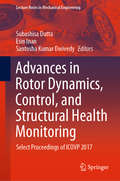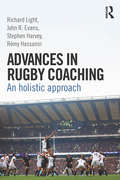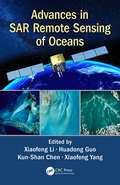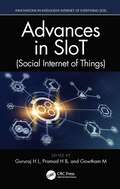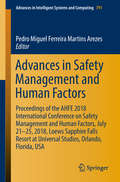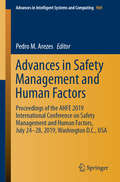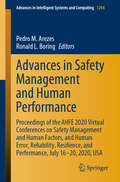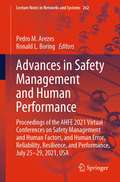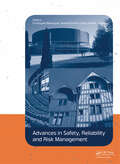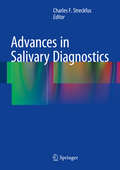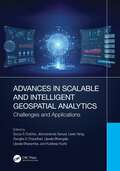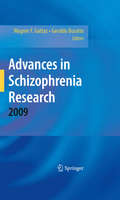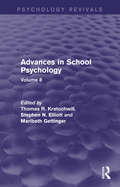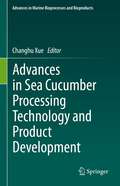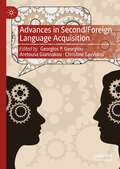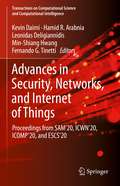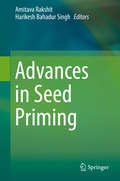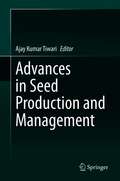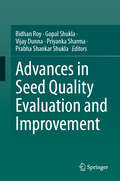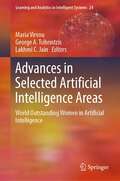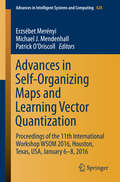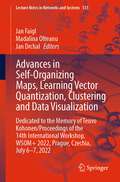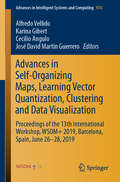- Table View
- List View
Advances in Rotor Dynamics, Control, and Structural Health Monitoring: Select Proceedings of ICOVP 2017 (Lecture Notes in Mechanical Engineering)
by Subashisa Dutta Santosha Kumar Dwivedy Esin InanThis book consists of selected and peer-reviewed papers presented at the 13th International Conference on Vibration Problems (ICOVP 2017). The topics covered in this book are broadly related to the fields of structural health monitoring, vibration control and rotor dynamics. In the structural health monitoring section studies on nonlinear dynamic analysis, damage identification, viscoelastic model of concrete, and seismic damage assessment are thoroughly discussed with analytical and numerical techniques. The vibration control part includes topics such as multi-storeyed stacked tuned mass dampers, vibration isolation with elastomeric mounts, and nonlinear active vibration absorber. This book will be useful for beginners, researchers and professionals interested in the field of vibration control, structural health monitoring and rotor dynamics.
Advances in Rugby Coaching: An Holistic Approach
by Richard Light Stephen Harvey John R. Evans Rémy HassaninContemporary sports coaching studies have moved beyond simple biophysical approaches to more complex understandings of coaching as a set of social relationships and processes. This is the first book to examine what that means in the context of one major international sport, rugby union. Drawing on cutting-edge empirical research in the five most powerful rugby-playing nations, as well as developments in pedagogical and social theory, the book argues for an holistic approach to coaching, coach development and player and team performance, helping to close the gap between coaching theory and applied practice. With player-centered approaches to coaching, such as Game Sense and Teaching Games for Understanding, at the heart of the book, it covers key contemporary topics in coach education such as: Long term coach development Experience and culture in coaching practice Positive coaching for youth rugby Improving decision-making ability Collaborative action research in rugby coaching Informed by work with elite-level rugby coaches, and examining coaching practice in both the full and sevens versions of the game, this book encourages the reader to think critically about their own coaching practice and to consider innovative new approaches to player and coach development. It is essential reading for all students of sports coaching with an interest in rugby, and for any coach, manager or administrator looking to develop better programmes in coach education.
Advances in SAR Remote Sensing of Oceans
by Xiaofeng Li, Huadong Guo, Kun-Shan Chen and Xiaofeng YangThe oceans cover approximately 71% of Earth’s surface, 90% of the biosphere and contains 97% of Earth’s water. Since the first launch of SEASAT satellite in 1978, an increasing number of SAR satellites have or will become available, such as the European Space Agency’s ERS-1/-2, ENVISAT, and Sentinel-1 series; the Canadian RADARSAT-1/-2 and the upcoming RADARSAT Constellation Mission series satellites; the Italian COSMO-SkyMed satellites, the German TERRASAR-X and TANDEM-X, and the Chinese GAOFEN-3 SAR, among others. Recently, European Space Agency has launched a new generation of SAR satellites, Sentinel-1A in 2014 and Sentinel-1B in 2016. These SAR satellites provide researchers with free and open SAR images necessary to carry out their research on the global oceans. The scope of Advances in SAR Remote Sensing of Oceans is to demonstrate the types of information that can be obtained from SAR images of the oceans, and the cutting-edge methods needed for analysing SAR images. Written by leading experts in the field, and divided into four sections, the book presents the basic principles of radar backscattering from the ocean surface; introduces the recent progresses in SAR remote sensing of dynamic coastal environment and management; discusses the state-of-the-art methods to monitor parameters or phenomena related to the dynamic ocean environment; and deals specifically with new techniques and findings of marine atmospheric boundary layer observations. Advances in SAR Remote Sensing of Oceans is a very comprehensive and up-to-date reference intended for use by graduate students, researchers, practitioners, and R&D engineers working in the vibrant field of oceans, interested to understand how SAR remote sensing can support oceanography research and applications.
Advances in SIoT (Innovations in Intelligent Internet of Everything (IoE))
by H L Gururaj H B Pramod M GowthamThe Social Internet of Things (SIoT) has become a hot topic in academic research. It employs the theory of social networks into the different levels of the Internet of Things (IoTs) and has brought new possibilities for the development of IoTs. Essentially, the SIoT is a subset of IoTs. It uses intelligent hardware and humans as the node, a social network as the organization type, the social relationship between things, things and humans, and between humans, formatting research methods and models with social network characteristics to realize the connection, service, and application of the IoTs. Moreover, SIoT is a form of realization of technology, architecture, and application of the IoTs using social network research methods. It further promotes the integration between real-world and virtual cyberspace, contributes the realization of the IoTs, expands the research scope of the social networking, and provides a new solution for the specific problems of the IoTs. Consequently, there is a tremendous need for researchers to have a comprehensive knowledge of the advances in SIoT. This special issue is soliciting scientific research papers that can present a snapshot of the latest research status of SIoT.
Advances in Safety Management and Human Factors: Proceedings of the AHFE 2017 International Conference on Safety Management and Human Factors, July 17–21, 2017, The Westin Bonaventure Hotel, Los Angeles, California, USA (Advances in Intelligent Systems and Computing #604)
by Pedro ArezesThis book discusses the latest findings on ensuring employees' safety, health, and welfare at work. It combines a range of disciplines - e. g. work physiology, health informatics, safety engineering, workplace design, injury prevention, and occupational psychology - and presents new strategies for safety management, including accident prevention methods such as performance testing and participatory ergonomics. The book, which is based on the AHFE 2017 International Conference on Safety Management and Human Factors, held on July 17-21, 2017, in Los Angeles, California, USA, provides readers, including decision makers, professional ergonomists and program managers in government and public authorities, with a timely snapshot of the state of the art in the field of safety, health, and welfare management. It also addresses agencies such as the Occupational Safety and Health Administration (OSHA) and the National Institute for Occupational Safety and Health (NIOSH), as well as other professionals dealing with occupational safety and health.
Advances in Safety Management and Human Factors: Proceedings of the AHFE 2018 International Conference on Safety Management and Human Factors, July 21-25, 2018, Loews Sapphire Falls Resort at Universal Studios, Orlando, Florida, USA (Advances in Intelligent Systems and Computing #791)
by Pedro Miguel ArezesThis book discusses the latest findings on ensuring employees’ safety, health, and welfare at work. It combines a range of disciplines – e.g. work physiology, health informatics, safety engineering, workplace design, injury prevention, and occupational psychology – and presents new strategies for safety management, including accident prevention methods such as performance testing and participatory ergonomics. The book, which is based on the AHFE 2018 International Conference on Safety Management and Human Factors, held on July 21–25, 2018, in Orlando, Florida, USA, provides readers, including decision makers, professional ergonomists and program managers in government and public authorities, with a timely snapshot of the state of the art in the field of safety, health, and welfare management. It also addresses agencies such as the Occupational Safety and Health Administration (OSHA) and the National Institute for Occupational Safety and Health (NIOSH), as well as other professionals dealing with occupational safety and health.
Advances in Safety Management and Human Factors: Proceedings of the AHFE 2019 International Conference on Safety Management and Human Factors, July 24-28, 2019, Washington D.C., USA (Advances in Intelligent Systems and Computing #969)
by Pedro M. ArezesThis book discusses the latest findings on ensuring employees’ safety, health, and welfare at work. It combines a range of disciplines – e.g. work physiology, health informatics, safety engineering, workplace design, injury prevention, and occupational psychology – and presents new strategies for safety management, including accident prevention methods such as performance testing and participatory ergonomics. The book, which is based on the AHFE 2019 International Conference on Safety Management and Human Factors, held on July 24-28, 2019, Washington D.C., USA, provides readers, including decision makers, professional ergonomists and program managers in government and public authorities, with a timely snapshot of the state of the art in the field of safety, health, and welfare management. It also addresses agencies such as the Occupational Safety and Health Administration (OSHA) and the National Institute for Occupational Safety and Health (NIOSH), as well as other professionals dealing with occupational safety and health.
Advances in Safety Management and Human Performance: Proceedings of the AHFE 2020 Virtual Conferences on Safety Management and Human Factors, and Human Error, Reliability, Resilience, and Performance, July 16-20, 2020, USA (Advances in Intelligent Systems and Computing #1204)
by Ronald L. Boring Pedro M. ArezesThis book brings together studies broadly addressing human error and safety management from the perspectives of various disciplines, and shares the latest findings on ensuring employees’ safety, health, and welfare at work. It combines a diverse range of disciplines – e.g. work physiology, health informatics, safety engineering, workplace design, injury prevention, and occupational psychology – and presents new strategies for safety management, including accident prevention methods such as performance testing and participatory ergonomics. It reports on cutting-edge methods and findings concerning safety-critical systems, defense, and security, and discusses advanced topics regarding human performance, human variability, and reliability analysis; medical, driver and pilot error, as well as automation error; and cognitive modeling of human error. Further, it highlights cutting-edge applications in safety management, defense, security, transportation, process controls, and medicine. Gathering the proceedings of the AHFE 2020 International Conference on Safety Management and Human Factors and the AHFE 2020 Virtual Conference on Human Error, Reliability, Resilience, and Performance, held on July 16–20, 2020, USA, the book offers an extensive, timely, and multidisciplinary guide for researchers and practitioners dealing with safety management and human error.
Advances in Safety Management and Human Performance: Proceedings of the AHFE 2021 Virtual Conferences on Safety Management and Human Factors, and Human Error, Reliability, Resilience, and Performance, July 25-29, 2021, USA (Lecture Notes in Networks and Systems #262)
by Ronald L. Boring Pedro M. ArezesThis book provides readers with a timely snapshot of research and developments relating to human reliability, performance and safety analysis, and human error, risk and safety management in various industrial contexts, such as manufacturing, transportation and health. It combines a diverse range of disciplines, including work physiology, health informatics, safety engineering, workplace design, injury prevention, and occupational psychology, and presents new strategies for safety management, accident prevention at the workplace, performance testing and participatory ergonomics. It discusses issues related to automation, and strategies for a safer Human-Automation Interaction. Based on the proceedings of the AHFE 2021 International Conferences on Safety Management and Human Factors, and Human Error, Reliability, Resilience, and Performance, which were held virtually on July 25-29, 2021, from USA, the book offers an extensive and inspiring guide for both researchers and practitioners dealing with the topics of safety management, human error prevention, and integration of automation in the workplace.
Advances in Safety, Reliability and Risk Management: ESREL 2011
by C. Guedes Soares Christophe Bérenguer Antoine GrallCovering a wide range of topics on safety, reliability and risk management, the present publication will be of interest to academics and professionals working in a wide range of scientific, industrial and governmental sectors, including: Aeronautics and Aerospace; Chemical and Process Industry; Civil Engineering; Critical Infrastructures; Energy; Information Technology and Telecommunications; Land Transportation; Manufacturing; Maritime Transportation; Mechanical Engineering; Natural Hazards; Nuclear Industry; Offshore Industry; Policy Making and Public Planning.
Advances in Salivary Diagnostics
by Charles F. StreckfusThis book reviews the progress made in salivary diagnostics during the past two decades and identifies the likely direction of future endeavors. After an introductory section describing the histological and anatomical features of the salivary glands and salivary function, salivary collection devices and diagnostic platforms are reviewed. The field of "salivaomics" is then considered in detail, covering, for example, proteomics, the peptidome, DNA and RNA analysis, biomarkers, and methods for biomarker discovery. Salivary diagnostics for oral and systemic diseases are thoroughly discussed, and the role of salivary gland tissue engineering for future diagnostics is explored. The book closes by considering legal issues and barriers to salivary diagnostic development. Advances in Salivary Diagnostics will be an informative and stimulating reference for both practitioners and students.
Advances in Scalable and Intelligent Geospatial Analytics: Challenges and Applications
by Surya S Durbha Sangita S Chaudhari Jibonananda Sanyal Lexie Yang Ujwala Bhangale Ujwala Bharambe Kuldeep KurteGeospatial data acquisition and analysis techniques have experienced tremendous growth in the last few years, providing an opportunity to solve previously unsolved environmental- and natural resource-related problems. However, a variety of challenges are encountered in processing the highly voluminous geospatial data in a scalable and efficient manner. Technological advancements in high-performance computing, computer vision, and big data analytics are enabling the processing of big geospatial data in an efficient and timely manner. Many geospatial communities have already adopted these techniques in multidisciplinary geospatial applications around the world. This book is a single source that offers a comprehensive overview of the state of the art and future developments in this domain. FEATURES Demonstrates the recent advances in geospatial analytics tools, technologies, and algorithms Provides insight and direction to the geospatial community regarding the future trends in scalable and intelligent geospatial analytics Exhibits recent geospatial applications and demonstrates innovative ways to use big geospatial data to address various domain-specific, real-world problems Recognizes the analytical and computational challenges posed and opportunities provided by the increased volume, velocity, and veracity of geospatial data This book is beneficial to graduate and postgraduate students, academicians, research scholars, working professionals, industry experts, and government research agencies working in the geospatial domain, where GIS and remote sensing are used for a variety of purposes. Readers will gain insights into the emerging trends on scalable geospatial data analytics.
Advances in Schizophrenia Research 2009
by Geraldo Busatto Filho Wagner F. GattazSchizophrenia remains an important challenge to psychiatry, with its causes and underlying brain mechanisms yet to be fully revealed. Currently available treatments are neither universally effective nor without unwanted effects. These aspects, together with the high prevalence of schizophrenia, its often debilitating nature, and the associated family and social burden, make this mental disorder one of the most complex public health issues of our times. The purpose of the Advances in Schizophrenia Research series is to provide comprehensive periodic reviews of the wide range of research studies carried out around the world, with the dual purpose of solving the schizophrenia puzzle, and providing clues to new forms of treatment and prevention for this disorder. A special feature of the series is its broad scope, virtually encompassing all fields of schizophrenia research: epidemiology and risk factors; psychopathology; diagnostic boundaries; cognition; outcome and prognosis; pathophysiology; genetics; pharmacological and psychological forms of treatment and rehabilitation; community care; and stigmatization.
Advances in School Psychology: Volume 8 (Psychology Revivals)
by Thomas R. Kratochwill Stephen N. Elliott Maribeth GettingerOriginally published in 1992, this title is the last in a series of books on school psychology. It contains diverse contributions relevant to school psychology, research, theory and practice at the time. Including chapters on alternative intervention strategies for the treatment of communication disorders, strategies for developing a preventive intervention for high-risk transfer children, a review of sociometry and temperament research, a review of the recent advances in research in training behavioral consultants at the time, and an overview of school-based consultation to support students with severe behavior problems in integrated education programs.
Advances in Science, Engineering and Technology
by Mohammad Faisal Suman Lata Tripathi Tasneem Ahmed Shrish BajpaiThe objective of the conference was to provide a common platform for innovative academicians and industrial experts working in the fields of sciences, engineering, and information technology. It provided a platform for knowledge exchange and the development of new ideas on the transformative technologies of quantum computing, video analytics, Artificial Intelligence, and Machine Learning. The conference also discussed the significance of cutting-edge technologies, specifically Machine Learning, and its pivotal role in the future of science and industry.
Advances in Sea Cucumber Processing Technology and Product Development (Advances in Marine Bioprocesses and Bioproducts)
by Changhu XueSea cucumbers belong to the Phylum Echinodermata. There are more than 900 recorded species of sea cucumber of which more than 40 are edible. As a food source, sea cucumbers are rich in protein, low in fat, rich in collagen, sulfated polysaccharides, phospholipids, glycolipids, saponins and other functional components. Therefore, sea cucumbers have important nutritional and medicinal value. Growing awareness of these health benefits has promoted growth in marine aquaculture and processing technologies for the development of sea cucumber products for many applications.Novel perspectives of nutritional functions and processing technologies of sea cucumbers are defined in this book. The chemical structure and nutritional function of sea cucumbers are systematically reviewed. These include the functional/nutritional components, the endogenous enzymatic properties related to processing efficiency and product quality, and the efficient preparation technology of functional components. The traditional processing technology is presented as the background context to highlight the advances in new processing technologies including low-temperature cooking technology based on controllable negative pressure system, heat pump-hot-blast air combined drying technology, microwave sterilization of instant sea cucumber, collagen stabilization technology. The book finishes with the authentication of sea cucumber types and origin, quality standards, product quality control systems and food safety requirements.
Advances in Second/Foreign Language Acquisition
by Georgios P. Georgiou Aretousa Giannakou Christine SavvidouThis book includes studies that employ a variety of research techniques from diverse fields targeting a better understanding of the second language (L2)/foreign language (FL) acquisition process including issues of heritage language (HL) learning. Specifically, the chapters discuss matters such as speech perception and production patterns in a second/foreign language, factors that facilitate second language acquisition, acquisition of heritage languages, teaching of a second/foreign language, and acquisition of second/foreign language grammatical and other structures, among others. The investigation of L2/FL and HLs is of paramount importance for updating the existing theories in the field and maximizing learning outcomes for the sake of effective communication, cultivation of intercultural understanding, career advancement, and personal development. The book is of interest to a wide range of disciplinary audiences, including linguists, psychologists, educators, and social scientists.
Advances in Security, Networks, and Internet of Things: Proceedings from SAM'20, ICWN'20, ICOMP'20, and ESCS'20 (Transactions on Computational Science and Computational Intelligence)
by Hamid R. Arabnia Kevin Daimi Leonidas Deligiannidis Min-Shiang Hwang Fernando G. TinettiThe book presents the proceedings of four conferences: The 19th International Conference on Security & Management (SAM'20), The 19th International Conference on Wireless Networks (ICWN'20), The 21st International Conference on Internet Computing & Internet of Things (ICOMP'20), and The 18th International Conference on Embedded Systems, Cyber-physical Systems (ESCS'20). The conferences took place in Las Vegas, NV, USA, July 27-30, 2020. The conferences are part of the larger 2020 World Congress in Computer Science, Computer Engineering, & Applied Computing (CSCE'20), which features 20 major tracks. Authors include academics, researchers, professionals, and students. Presents the proceedings of four conferences as part of the 2020 World Congress in Computer Science, Computer Engineering, & Applied Computing (CSCE'20);Includes the tracks on security & management, wireless networks, internet computing and IoT, and embedded systems as well as cyber-physical systems;Features papers from SAM’20, ICWN’20, ICOMP’20 and ESCS’20.
Advances in Seed Priming
by Harikesh Bahadur Singh Amitava RakshitMost crop plants grow in environments that are suboptimal, which prevents the plants from attaining their full genetic potential for growth and reproduction. Stress due to abiotic and biotic agents has a significant effect on world food production. Annually, an estimated 15% of global yields are lost, but this figure belies far greater losses for specific food systems and the people whose existence is dependent upon them, particularly in developing countries. Current efforts to mitigate these losses are worryingly over-reliant on the use of sophisticated and costly chemicals /measures with substantial economic and environmental costs, or on the development of efficient and smart crop varieties, which can take decades. What we need is a broad range of safe, robust and equitable solutions for food producers. One under-investigated approach is that of utilizing the crop plant’s innate immune system to resist stress. More specifically, the innate immune system can be sensitized or ‘primed’ to respond more quickly and strongly to protect the plant against stresses. However, a strategy of employing priming in combination with reduced pesticide use can enhance protection, and help to meet commitments to reducing chemical inputs in agriculture. This book discusses in detail different segments of priming in addressing stress factors and traits to increase competitiveness against all odds. Adopting a holistic and systematic approach, it addresses priming to counter climate-change related adverse effects coupled with pest and pathogen related stress on the productivity of crops utilizing natural resources to reap sustainable environmental, economic and social benefits for potential productivity of crops, maintaining synergy between soil, water and plants in ways that mimic nature.
Advances in Seed Production and Management
by Ajay Kumar TiwariHigh-quality seed is essential for healthy crops and greater agricultural productivity. At the same time, advances in breeding technology require equivalent advances in seed technology. In order to ensure food security, it is crucial to develop seeds that are high yielding, and resistant to drought, heat, cold, and insects. Gathering the latest research in seed sciences, the book includes contributions on seed production in crops such as legumes, sugar, rice, wheat and other cereals. It discusses a range of topics, like the effect of climate change on seed quality, production and storage; seed rouging; seed certification for different crop species; seed biology; and seed pathologies and their effective management. Integrating basic and applied research, this compendium provides valuable insights for researchers and students in agricultural and life sciences; professionals involved in seed certification and those working in quarantine laboratories; as well as plant pathologists.
Advances in Seed Quality Evaluation and Improvement
by Gopal Shukla Priyanka Sharma Bidhan Roy Vijay Dunna Prabha Shankar ShuklaThis book discusses various aspects of Seed Science and Technology including seed production, seed certification, seed quality enhancements, seed testing and harvesting, and post-harvest management. Continued efforts are being made to preserve plant genetic resources over long term in order to conserve biodiversity and provide food security. Seed and germplasm repositories hold high importance in this regard. Various technologies such as cryopreservation is being commonly employed to preserve seeds and plant tissues at extremely low temperatures. This book discusses the advancements of data storage and information management systems that have aided in the creation of extensive seed databases, and thus enabling researchers to quickly catalogue and access data on seed kinds, properties and availability. This book also explains the sophisticated technologies such as nanobiotechnology, machine learning, artificial intelligence, magnetic resonance and multispectral imaging which are currently being used for examining seed quality, genetic analysis, seed preservation and seed handling operations. The scope of these technologies in increasing the effectiveness and precision of seed research, developing better crop varieties and promoting sustainable environmental preservation has also been covered. This book is a reference source for Scientists, researchers and authorities involved in the production and certification of seeds. It is also valuable for seed experts working in the public and commercial sectors globally.
Advances in Selected Artificial Intelligence Areas: World Outstanding Women in Artificial Intelligence (Learning and Analytics in Intelligent Systems #24)
by Lakhmi C. Jain Maria Virvou George A. TsihrintzisAs new technological challenges are perpetually arising, Artificial Intelligence research interests are focusing on the incorporation of improvement abilities into machines in an effort to make them more efficient and more useful. Recent reports indicate that the demand for scientists with Artificial Intelligence skills significantly exceeds the market availability and that this shortage will intensify further in the years to come. A potential solution includes attracting more women into the field, as women currently make up only 26 percent of Artificial Intelligence positions in the workforce. The present book serves a dual purpose: On one hand, it sheds light on the very significant research led by women in areas of Artificial Intelligence, in hopes of inspiring other women to follow studies in the area and get involved in related research. On the other hand, it highlights the state-of-the-art and current research in selected Artificial Intelligence areas and applications. The book consists of an editorial note and an additional thirteen (13) chapters, all authored by invited women-researchers who work on various Artificial Intelligence areas and stand out for their significant research contributions. In more detail, the chapters in the book are organized into three parts, namely (i) Advances in Artificial Intelligence Paradigms, (ii) Advances in Artificial Intelligence Applications, and (iii) Recent Trends in Artificial Intelligence Areas and Applications. This research book is directed towards professors, researchers, scientists, engineers and students in Artificial Intelligence-related disciplines. It is also directed towards readers who come from other disciplines and are interested in becoming versed in some of the most recent Artificial Intelligence-based technologies. An extensive list of bibliographic references at the end of each chapter guides the readers to probe further into the Artificial Intelligence areas of interest to them.
Advances in Self-Organizing Maps and Learning Vector Quantization: Proceedings of the 11th International Workshop WSOM 2016, Houston, Texas, USA, January 6-8, 2016 (Advances in Intelligent Systems and Computing #428)
by Erzsébet Merényi Michael J. Mendenhall Patrick O'DriscollThis book contains the articles from the international conference 11th Workshop on Self-Organizing Maps 2016 (WSOM 2016), held at Rice University in Houston, Texas, 6-8 January 2016. WSOM is a biennial international conference series starting with WSOM'97 in Helsinki, Finland, under the guidance and direction of Professor Tuevo Kohonen (Emeritus Professor, Academy of Finland). WSOM brings together the state-of-the-art theory and applications in Competitive Learning Neural Networks: SOMs, LVQs and related paradigms of unsupervised and supervised vector quantization. The current proceedings present the expert body of knowledge of 93 authors from 15 countries in 31 peer reviewed contributions. It includes papers and abstracts from the WSOM 2016 invited speakers representing leading researchers in the theory and real-world applications of Self-Organizing Maps and Learning Vector Quantization: Professor Marie Cottrell (Universite Paris 1 Pantheon Sorbonne, France), Professor Pablo Estevez (University of Chile and Millennium Instituteof Astrophysics, Chile), and Professor Risto Miikkulainen (University of Texas at Austin, USA). The book comprises a diverse set of theoretical works on Self-Organizing Maps, Neural Gas, Learning Vector Quantization and related topics, and an excellent variety of applications to data visualization, clustering, classification, language processing, robotic control, planning, and to the analysis of astronomical data, brain images, clinical data, time series, and agricultural data.
Advances in Self-Organizing Maps, Learning Vector Quantization, Clustering and Data Visualization: Dedicated to the Memory of Teuvo Kohonen / Proceedings of the 14th International Workshop, WSOM+ 2022, Prague, Czechia, July 6-7, 2022 (Lecture Notes in Networks and Systems #533)
by Jan Faigl Madalina Olteanu Jan DrchalIn this collection, the reader can find recent advancements in self-organizing maps (SOMs) and learning vector quantization (LVQ), including progressive ideas on exploiting features of parallel computing. The collection is balanced in presenting novel theoretical contributions with applied results in traditional fields of SOMs, such as visualization problems and data analysis. Besides, the collection further includes less traditional deployments in trajectory clustering and recent results on exploiting quantum computation. The presented book is worth interest to data analysis and machine learning researchers and practitioners, specifically those interested in being updated with current developments in unsupervised learning, data visualization, and self-organization.
Advances in Self-Organizing Maps, Learning Vector Quantization, Clustering and Data Visualization: Proceedings of the 13th International Workshop, WSOM+ 2019, Barcelona, Spain, June 26-28, 2019 (Advances in Intelligent Systems and Computing #976)
by Alfredo Vellido Karina Gibert Cecilio Angulo José David Martín GuerreroThis book gathers papers presented at the 13th International Workshop on Self-Organizing Maps, Learning Vector Quantization, Clustering and Data Visualization (WSOM+), which was held in Barcelona, Spain, from the 26th to the 28th of June 2019. Since being founded in 1997, the conference has showcased the state of the art in unsupervised machine learning methods related to the successful and widely used self-organizing map (SOM) method, and extending its scope to clustering and data visualization. In this installment of the AISC series, the reader will find theoretical research on SOM, LVQ and related methods, as well as numerous applications to problems in fields ranging from business and engineering to the life sciences. Given the scope of its coverage, the book will be of interest to machine learning researchers and practitioners in general and, more specifically, to those looking for the latest developments in unsupervised learning and data visualization.
